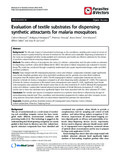| dc.description.abstract | Background
The full-scale impact of odour-baited technology on the surveillance, sampling and control of vectors of infectious diseases is partly limited by the lack of methods for the efficient and sustainable dispensing of attractants. In this study we investigated whether locally-available and commonly used textiles are efficient substrates for the release of synthetic odorant blends attracting malaria mosquitoes.
Methods
The relative efficacy of (a) polyester, (b) cotton, (c) cellulose + polyacrylate, and (d) nylon textiles as substrates for dispensing a synthetic odour blend (Ifakara blend 1(IB1)) that attracts malaria mosquitoes was evaluated in western Kenya. The study was conducted through completely randomized Latin square experimental designs under semi-field and field conditions.
Results
Traps charged with IB1-impregnated polyester, cotton and cellulose + polyacrylate materials caught significantly more female Anopheles gambiae sensu stricto (semi-field conditions) and An. gambiae sensu lato (field conditions) mosquitoes than IB1-treated nylon (P = 0.001). The IB1-impregnated cellulose + polyacrylate material was the most attractive to female An. funestus mosquitoes compared to all other dispensing textile substrates (P < 0.001). The responses of female An. funestus mosquitoes to IB1-treated cotton and polyester were equal (P = 0.45). Significantly more female Culex mosquitoes were attracted to IB1-treated cotton than to the other treatments (P < 0.001). Whereas IB1-impregnated cotton and cellulose + polyacrylate material attracted equal numbers of female Mansonia mosquitoes (P = 0.44), the catches due to these two substrates were significantly higher than those associated with the other substrates (P < 0.001).
Conclusion
The number and species of mosquitoes attracted to a synthetic odour blend is influenced by the type of odour-dispensing material used. Thus, surveillance and intervention programmes for malaria and other mosquito vectors using attractive odour baits should select an odour-release material that optimizes the odour blend. | en_US |

